Abstract
In this paper, raw jute fabric was subjected to atmospheric pressure dielectric barrier discharge (at 150 or 300 Hz) to enhance its wettability, i.e., capillarity and wetting time. Attenuated Total Reflectance-Fourier Transform Infrared (ATR-FTIR) spectroscopy and Field Emission Scanning Electron Microscopy (FE-SEM) were used to assess the changes in the fabrics’ surface chemistry and morphology induced by plasma treatments. The obtained results revealed that both plasma treatments enhanced the wettability of jute fabrics, which could be ascribed to the changes in the fibers’ surface chemistry (the removal of non-cellulosic components, exposure of the cellulose molecules, and oxidation) and morphology (increased roughness due to etching of the surface layers and partial fibrillation). Capillary rise heights increased by approximately 1.8 and 1.9 times, and wetting times were 35 and 34 times shorter 24 h after the plasma treatment at 150 and 300 Hz, respectively. Special attention was given to the aging effect of plasma treatment indicated no significant changes in the fabrics’ capillarity and wetting time after 28 and 7 days, respectively, proving the durability of the effects of plasma treatment. Plasma-treated raw jute fabrics could be used as water-binding geo-prebiotic polysaccharide supports to provide the necessary water for the initial growth of cyanobacterial biocrusts. The lack of moisture is the main constraint in biocrust development after cyanobacterial inoculation. The combination of such water-supportive fabrics and cyanobacterial strains could be used for the rehabilitation of various degraded lands, sediments, and substrates, as well as for air and water pollution control.
1. Introduction
Analysis of the global production of natural fibers shows that in recent decades, jute has ranked as the second most important natural fiber after cotton. According to the Food and Agricultural Organization of the United Nations [1], 2.69 million t of jute were produced in 2020, with the most harvested areas located in India (690,000 ha) and Bangladesh (680,000 ha). A less known but no less important fact is that 1 ha of jute plants consumes about 15,000 kg of CO2 from the atmosphere and provides about 11,000 kg of O2 during the 100-day growing season, which is much higher than the O2 production of many tree species [2]. This sustainable fiber is widely used for the production of conventional textile products such as hessian, carpet backing cloth, sacking, and shopping bags [3]. It is interesting to note that all these products are usually made of raw jute fabric that has not been subjected to any treatments.
Morphologically, raw jute exists as a technical fiber comprised of 6–20 elementary fibers; each elementary fiber represents a network of ultrafine cellulose fibrils protected by a matrix of hemicelluloses, lignin, and other minor non-cellulosic components [4]. Thanks to such complex chemical composition and the specific location of the main constituents, i.e., layered fiber structure (consisting of the middle lamella and primary and secondary cell walls), jute is a convenient candidate for various modifications. Conventional wet chemical modifications such as alkali scouring and oxidation (i.e., bleaching) [5,6,7] lead to the removal of hemicelluloses and lignin, hence, obtaining cellulose-rich fibers with improved mechanical, electrophysical, thermal, electrokinetic, and/or sorption properties. In such a way, the application of jute fiber can be significantly broadened from conventional textile products to high-performance products [8,9]. In particular, chemically modified jute can be used for energy storage [10], as an insulation material [11], and as protective clothing in environments sensitive to electrical discharges [12,13]. It has also found applications in electrical engineering, flexible electronics, fabric-based electromagnetic shielding devices [7], etc. However, it should be kept in mind that most of the wet chemical modifications consume various hazardous agents, and the release of untreated industrial effluents in rivers gives rise to environmental pollution [14]. In that regard, researchers from all over the world are orienting their work towards sustainable and eco-friendly methods for jute fiber modification.
With reference to several studies [4,15,16,17,18] in which the sorption properties of raw jute fabric were enhanced by different alkali or oxidative chemical modifications, we decided to use alternative treatment, i.e., green, clean, and sustainable atmospheric pressure plasma treatment to achieve the same effect. Plasma treatment has been used frequently for cotton processing [19,20,21,22,23], as it minimizes water, energy, and chemical consumption [24]. In a detailed literature search, we found only two papers dealing with the effect of plasma treatment on the wettability of jute fabric. Bozaci et al. [25] studied the influence of atmospheric plasma treatment power and time on the capillarity of raw jute fabric and concluded that capillarity increases proportionally to the increase in plasma treatment power and time and is conditioned by surface etching. Furthermore, in a study conducted by Kafi et al. [26], jute fabric was treated for different times under atmospheric plasma glow discharge using helium, helium/nitrogen, or helium/acetylene gas. The researchers reported that, independent of the studied gas, 10 s of plasma treatment was sufficient to significantly improve the wetting behavior of jute fabric [26]. Neither of the papers mentioned above included an in-depth discussion regarding the plasma treatment effects on the jute surface chemistry and morphology; therefore, the connection between these properties and jute fabric wettability remains unexplored. The wettability of plasma-treated hemp [27], ramie [28], abaca, flax, hemp, and sisal [29] fibers has been studied. Pejic et al. [30] monitored the effect of the chemical composition of hemp fibers on the efficiency of plasma treatments to elucidate the sensitivity of the main components of hemp fibers (cellulose, hemicelluloses, and lignin) to the plasma treatment and to identify optimal treatment parameters for enhancing hemp sorption properties.
In this article, we focus on the effect of atmospheric pressure plasma (at 150 and 300 Hz) obtained in air on the wettability of raw jute fabric evaluated according to changes in capillary rise height and wetting time. First, the plasma-treated fabrics were characterized in terms of their surface chemistry and morphology using Attenuated Total Reflectance-Fourier Transform Infrared (ATR-FTIR) spectroscopy and Field Emission Scanning Electron Microscopy (FE-SEM), respectively. Thereafter, a connection between these properties and fabric wettability was established and discussed in detail. Taking into account the known fact that the effects of plasma treatment can diminish over time, special attention was given to the aging effect of plasma treatment on the wettability of jute fabric.
It has to be emphasized that a possible novel application of raw jute fabric in biocarpet engineering [31] stands behind the need to improve its wettability using sustainable plasma treatment. Over 40% of terrestrial ecosystems worldwide suffer from land degradation, a natural or human-influenced process that affects the functionality of the land. Eolian erosion of desertified and damaged land surfaces consequently causes air pollution and associated water pollution. For these reasons, the concept of Biological Soil Crust (BSC) carpet engineering has been proposed [32], and cyanobacterial crusts as primary colonizers have been introduced as a potential solution. However, rehabilitation takes a long time [33] (tens of years or even centuries) due to the lack of moisture during the initial development phase of cyanobacterial crusts. In order to solve the problems and constraints of slow crust development during the initial phase, special geo-prebiotic (promoting terrestrial microbiota) support is needed. A combination of water-supportive plasma-treated jute fabrics (that could provide the necessary moisture in the phase of cyanobacterial inoculation) and selected autochthonous cyanobacterial strains with sticky egzopolysaccharides is recommended for the rehabilitation of various degraded lands, sediments, and substrates, as well as air and water pollution control. Sticky cyanobacterial polysaccharides capture airborne particles during the wet phase. During the dry phase, the biocrusts stabilize the degraded surface, process captured particles, and prevent wind and water erosion.
2. Materials and Methods
2.1. Material
A commercially produced raw jute fabric with a plain weave was used as the experimental material; it had following chemical composition: 2.45% water-solubles, 0.68% fats and waxes, 1.82% pectin, 13.68% lignin, 16.82% hemicelluloses, and 64.53% α-cellulose. The thickness, weight, porosity, and density in warp and weft directions of the raw (untreated) jute fabric were 0.762 mm, 266 g/m2, 61.0%, 46 1/dm, and 46 1/dm, respectively.
The raw jute fabric used in this study is characterized by a maximum force of 537.3 N, elongation at a maximum force of 5.66%, a volume electrical resistivity of 12.21 GΩcm measured under 40% air humidity (all determined in the weft direction) [34], and an AC-specific electrical conductivity of 0.095 μSm−1 at a frequency of 130 kHz under 30% air humidity [15]. Moisture sorption and water retention power of the examined raw jute fabric accounted for 7.41 and 57.23%, respectively. Concerning the fabric electrokinetic properties, the pH value at which the lowest zeta potential was detected was 3.82, with a minimum zeta potential value of −11.17 mV and a fabric isoelectric point of 2.52 [35].
2.2. Plasma Treatment
Raw jute fabric was treated with plasma obtained by dielectric barrier discharge (DBD) in open air at atmospheric pressure (Figure 1) [30]. The discharge was generated between two plane-parallel electrodes (8 cm × 20 cm) covered by a 0.7 mm thick alumina sheet (10 cm × 22 cm). An upper electrode was set at AC high voltage, while the lower electrode was connected to the ground through a 14 kOhm capacitor. The voltage applied to the electrodes was measured using a high-voltage Tektronix P6015A (Tektronix, China). The low-frequency AC power supply used in this study consists of a high-voltage transformer and a frequency inverter (Emerson Commander SKA 1200075AC variable-speed drive), which allows for variation of the sinusoidal voltage amplitude and frequency. The distance between the electrodes was fixed by glass space holders to ensure a fixed discharge gap of 3 mm. Granules of zeolite were used during the plasma treatment of fabrics in order to avoid the problem of humidity and to maintain a homogeneous discharge [36]. Raw jute fabric (labeled as J) with dimensions of 20 cm × 8 cm (in the warp direction) was treated under two different regimes of discharge. The first regime involves the use of the following parameters: 150 Hz, 15.2 kV, 120 s (fabric marked as J150); in the case of the second regime, the parameters were set as follows: 300 Hz, 12.6 kV, 120 s (fabric denoted as J300). The plasma treatment conditions were chosen with the intention of determining which parameter has a decisive influence on fabric treatment: the applied energy (35% higher for 300 Hz frequency) or the applied voltage (20% higher for 150 Hz frequency).
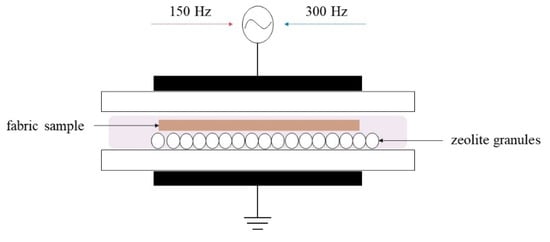
Figure 1.
Scheme of the DBD device with zeolite.
2.3. Characterization of the Plasma-Treated Fabrics
ATR-FTIR spectra of the fabrics were recorded in absorbance mode using a Nicolet™ iS™ 10 FT-IR spectrometer (Thermo Fisher Scientific, Waltham, MA, USA) with Smart iTR™ attenuated total reflectance sampling accessories within a range of 4000–400 cm−1, at a resolution of 4 cm−1, and in 20 scan mode.
FE-SEM MIRA 3 XMU (Tescan, Brno, Czech Republic) was used to investigate the surface morphology of raw and plasma-treated jute fibers. Before the analysis, the fibers were sputter-coated with Au/Pd alloy using a Polaron SC502 Sputter Coater (Fison Instruments, Glasgow, UK).
2.4. Wettability Measurements
The wettability of jute fabric was assessed according to changes in capillary rise height and wetting time. The method used to determine capillary rise height is similar to that used in the literature [4]. In particular, the jute fabrics (20 cm × 2 cm in the warp direction) were placed in a vertical position. One end was fixed with a clip on a horizontal bar, while the other end was preloaded with a tag and immersed to a dept of approximately 1 cm in a 1% aqueous solution of eosin (red-colored solution). When the fabrics were immersed in eosin, photos were taken at time intervals of 15 s for the first minute, every 30 s up to 5 min, and every 1 min up to 10 min. Capillary measurements were carried out on the raw fabric as well as 1, 14, and 28 days after the plasma treatment (fabrics marked as J150/1day, J150/14days, J150/28days, J300/1day, J300/14days, and J300/28days) to investigate the effect of aging on fabric capillarity. The results are presented as mean values of three readings per sample. Based on the experimental data obtained by capillarity measurements and the methodology outlined by Pejić et al. [30], the capillary diffusion coefficient (D, mm2/s) was determined using Equation (1).
where h (mm) is the increase in capillary rise height, and t (s) is time.
The fabric wetting time was determined according to standard AATCC 79-2018. A drop of distilled water (30 µL volume) was placed on the fabric surface from a distance of 9.5 ± 1.0 mm. The time required for the droplet to be absorbed by the sample was recorded on a stopwatch and taken as the wetting time. Measurements were performed on raw jute fabric, as well as 1 and 7 days after plasma treatment (fabrics codes: J150/1day, J150/7days, J300/1day, and J300/7days). For each fabric, five measurements were recorded, and the mean value was expressed as wetting time.
3. Results and Discussion
3.1. Characterization of the Raw and Plasma-Treated Jute Fabrics
Before studying the effect of plasma treatments on the wettability of raw jute fabric, the changes in its surface chemistry and morphology were elucidated by using ATR-FTIR spectroscopy and FE-SEM, respectively.
Considering the ATR-FTIR spectra of raw and plasma-treated fabrics in parallel (Figure 2), it is evident that the intensity and/or the position of some bands corresponding to different functional groups originating from the jute fiber constituents were changed after the plasma treatments.
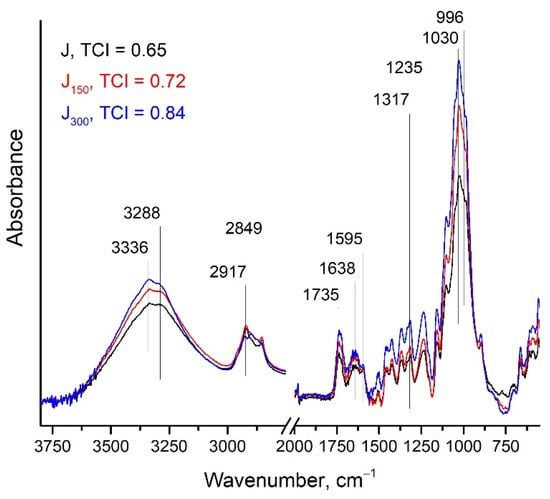
Figure 2.
ATR-FTIR spectra of raw and plasma-treated jute fabrics.
As previously mentioned, raw jute consists of cellulose, hemicelluloses, lignin, and some minor components distributed in the complex layered fiber structure covered by surface impurities. After the plasma treatments, the intensities and positions of the bands at 2917 and 2849 cm−1 (assigned to C–H stretching vibration of CH2 and CH groups in cellulose and hemicelluloses [37]) changed, indicating that some jute surface impurities (such as waxes, and bit-shaped pectin [38]) were removed. This statement is additionally supported by the FE-SEM microphotographs (Figure 3); due to surface ablation, only a small amount of impurities can be observed on the J300 fiber surface.
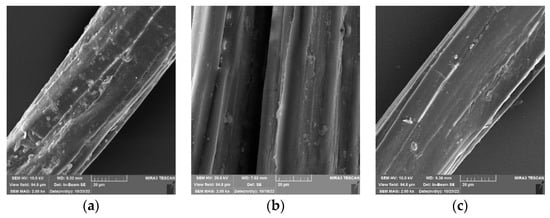
Figure 3.
FE-SEM microphotographs of (a) J, (b) J150, and (c) J300 (magnification ×2000).
Furthermore, the intensity of the broad band within the range 3600 and 3000 cm−1 (comprised of band shoulders centered at 3336 and 3288 cm−1) assigned to O–H stretching vibrations in the cellulose [39] increased with increasing the plasma frequency. This behavior is, on one hand, attributed to the formation of new oxygen-containing groups when free radicals reacted with surrounding oxygen [38], inducing changes in intra- and intermolecular cellulose bonds [40] and, on the other hand, to the more exposed cellulose on the fiber surface. The latter was also confirmed by the increased intensity of the band at 1235 cm−1 originating from the C–O–C asymmetric stretching vibration of cellulose [41] after the plasma treatments.
Based on previous investigations focused on plasma-treated hemp fibers [30], i.e., the susceptibility to plasma etching of the hemicelluloses and cellulose amorphous regions on the fiber surface, hemicelluloses’ removal and increased fiber crystallinity were expected upon plasma treatment. Contrary to expectations, the intensities of the bands at 1735 cm−1 and 1638 cm−1 assigned to the absorptions of carbonyl (C=O) linkage and carboxyl stretching of carboxylic acid or ester group present in hemicelluloses [42] but also in oxidized cellulose increased with increased plasma frequency. Considering that carboxyl groups are not present in native cellulose, given the calculated hemicellulose/cellulose ratios [43] of 1.05 and 0.89 for fabrics J and J300, respectively, it is clear that partial hemicelluloses’ removal occurred but was masked by cellulose oxidation. The findings reported in the present study are consistent with the previous observations by various research groups. Kafi et al. [26] concluded that oxygen-based reactive species (derived from atmospheric oxygen) most likely developed due to the removal of an outermost layer from jute. Huner et al. [44] reported that a reaction with oxygen is possible when dry air plasma breaks the C–C bonds within cellulose so that new C–OH bonds can be formed, resulting in an increased intensity of the band at 1030 cm−1 (C–OH vibration in cellulose), as also observed in Figure 2. In addition to the removal of hemicelluloses and cellulose oxidation, an increase in the total crystallinity index (TCI, i.e., ratio of the intensities of the bands at 1372 and 2900 cm−1 which is directly proportional to the fiber crystallinity degree [45]) of plasma-treated fibers was observed. In particular, samples J, J150, and J300 had TCIs of 0.65, 0.72, and 0.84, respectively (Figure 2), confirming that amorphous regions on the fiber surface were affected by plasma treatments.
It has to be noted that the mentioned pronounced surface etching and partial fibrillation (Figure 4) are also the reasons behind the exposure of the internal lignin-containing structure of the middle lamella and primary wall on the fiber surface. The latter was proven by the increased intensities of the bands in the region of 1595−1240 cm−1 assigned to the aromatic structures of lignin [30,43] and a shoulder at 996 cm−1 (aromatic C–H in-plane deformation and C–O deformation of a primary alcohol in lignin [25]) after the plasma treatments.
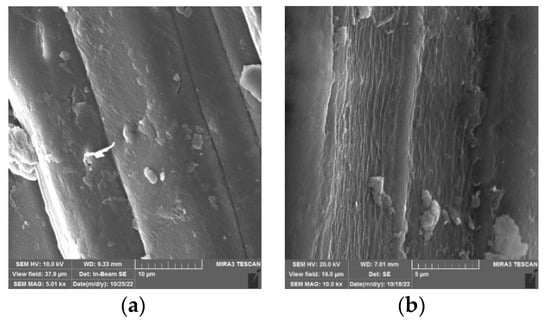
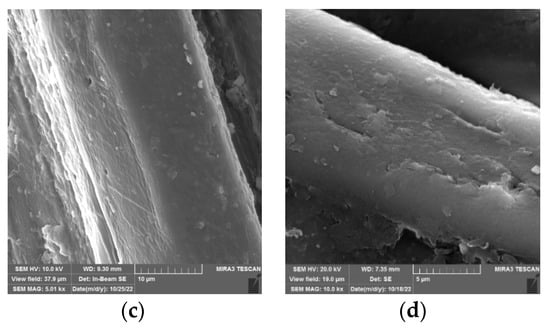
Figure 4.
FE-SEM microphotographs of: (a) and (b) J150 and (c) and (d) J300.
The discussed ATR-FTIR spectra and FE-SEM images are strong evidence that plasma treatments at atmospheric pressure can alter the surface chemistry and morphology of jute fabric.
3.2. Wettability of the Investigated Jute Fabrics
In this section, the impact of plasma treatments on fabric wettability was studied, and changes in capillary rise height and wetting time were selected as important wettability parameters. The measurements of fabric capillarity implicate simultaneous wetting of the fabric surface, liquid uptake in the pore structures/capillary penetration, adsorption on the fabric surface, and liquid absorption within the fabric [30]. This wettability parameter also represents an indicator of the treatment homogeneity [25]; if the treatment caused homogenous changes in the fabric’s chemistry and morphology, the increase in capillarity height would be similar for every yarn of the tested fabric. On the other hand, knowing that plasma treatment induced a fabric surface modification, the determination of wetting time represents a very quick method for assessment of the changes in wettability induced by the plasma treatment.
3.2.1. Capillarity Rise Height of Raw and Plasma Treated Jute Fabrics
It is apparent from Figure 5 that compared to raw samples, plasma-treated jute fabrics have a significantly faster capillary rise height (in further text: h) within the studied time interval. The differences between the fabrics’ h values are the highest at the beginning of the measurement; after 30 s, fabrics J150/1day and J300/1day have 5.9 and 8.7 times higher h values than raw jute fabric. Strong evidence of the abovementioned phenomenon are the diffusion coefficients (Figure 6), which are about four times higher for plasma-treated jute fabric than for raw jute fabric. The high h values of plasma-treated fabrics can be ascribed to the previously discussed changes in the fiber surface chemistry. More precisely, the removal of surface impurities and partial hemicelluloses’ removal, cellulose and lignin-enrichment of the fiber surface, and cellulose oxidation resulted in improved capillarity. All these contributors acting in parallel enabled better water penetration into the capillary system of the fiber cell wall [46] with simultaneous interaction between water and newly formed oxygen-containing groups (Figure 2). Consequently, fiber and yarn swelling occurred, which reduced the capillary spaces within the fibers and between the yarns, resulting in higher capillary pressure in smaller pores, i.e., improved capillarity was obtained [4]. As a result of fiber etching and ablation, increased fiber roughness, the formation of micro pits, and partial fibrillation occurred (Figure 4), which should not be neglected. Pronounced pitting and fibrillation are the main reasons why fabric J300/1day has slightly higher h values compared to fiber J150/1day. In particular, between completely or partially separated elementary fibers (within technical jute fiber), new capillary spaces capable of transferring fluid were created and acted as a void system [47]. The same observations were reported by Pejic et al. [30], i.e., that capillary equilibrium height of raw hemp fibers (accounting for 8.8 mm) increased to 36.0 and 46.0 mm after the plasma treatment at 150 and 300 Hz, respectively. Similarly, Bozaci et al. [25] found that the improvement in jute capillarity, mainly as a consequence of the surface roughening and the formation of micro pits, is highly dependent on the applied plasma power and exposure time. A comparison of the results presented in Figure 5 with the results obtained for the alkali- and oxidatively treated jute fabrics [4] clearly shows that plasma treatment can compete and is more effective than the applied chemical treatments in terms of the h values of the fabrics. For example, after the alkali or oxidative treatment under severe conditions, h values measured after 600 s were 71.2–81.0 mm and 45.2–75.0 mm, respectively, while for the same duration, h values of fabrics J150/1day and J300/1day were 86.3 and 91.3 mm (Figure 5), respectively. This comparison clearly indicates that the plasma treatment not only enhanced fabric h values but is also within the window of sustainability, enabling a step towards energy-saving treatment and a clearer and healthier environment by avoiding the use of chemicals. In this example, both alkali and oxidative treatments produce large amounts of wastewater because of the high alkali concentration (17.5% NaOH) and strong oxidative agent (NaClO2) with a high fiber-to-liquid ratio (1:50), including additional chemicals used for fiber rinsing after the modifications.

Figure 5.
Effect of plasma treatment frequency on the capillary rise height (h) of jute fabrics.
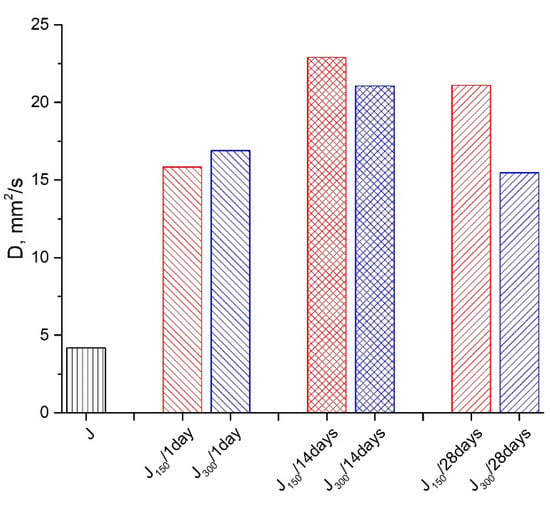
Figure 6.
Diffusion coefficients (D) of raw and plasma-treated fabrics at different frequencies.
An aging effect often occurs after plasma treatments, as manifested by changes in the activated fiber surface over time or by reversal of achieved effects through the recombination of functional groups on the fiber surface [23]. Therefore, special attention was paid to the h of plasma-treated fabrics aged for 1, 14, and 28 days. Interestingly, the results presented in Figure 7a indicate that the aging of plasma-treated fabrics led to an improvement in their h values. In particular fabrics aged for 14 and 28 days (J150/14 days and J150/28 days, respectively) had about 16% higher h values than the fabric aged for 1 day (J150/1 day). The situation is somewhat different in the case of fabric treated at a frequency of 300 Hz (Figure 7b). It is evident that after 14 days of aging, the h of fabric J300/14 days slightly improved (about 8%), and after 28 days of aging, returned to the initial value. Kramar et al. [48] identified the same phenomenon with respect to the capillarity of plasma-treated viscose fabric, which increased up to 14 days of aging. As illustrated in Figure 6, both J150/14 days and J150/28 days fabrics showed higher diffusion coefficients than J150/1 day, while in the case of fabrics treated at a frequency of 300 Hz, the highest diffusion coefficient was registered after 14 days of aging, followed by a significant decrease, i.e., after 28 days of aging, the diffusion coefficient decreased and was lower than that of J300/1 day.
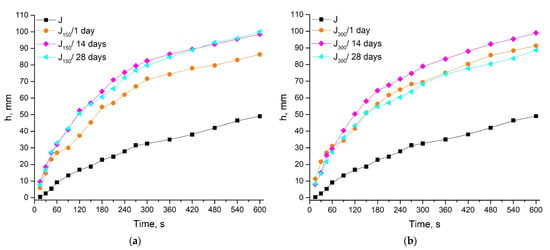
Figure 7.
Effect of aging on the capillary rise height (h) of plasma-treated jute fabrics at (a) 150 Hz and (b) 300 Hz.
3.2.2. Wetting Time
The wettability of the studied jute fabrics was further evaluated by determining wetting time (Figure 8). Surprisingly, immediately after the plasma treatment, about 31 and 26 times lower wetting times were recorded for fabrics J150 and J300, respectively. Such changes are undoubtedly related to the surface polarity (i.e., formation of new surface functional groups) and morphology (i.e., etching and roughness), which, together, promote quick and easy penetration and adsorption of water drop within the fabric. According to Dimic Misic et al. [49], the surface roughness increases the effective wetting area; water fills the roughened surface, making contact with the entire surface. On the other hand, the authors of [26] proposed that the removal of the waxy and pectin layer from the outermost jute fiber surface through atmospheric plasma in air improves the wetting properties of the fabric.
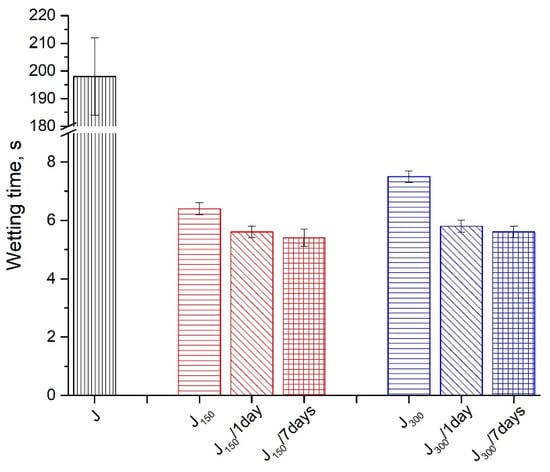
Figure 8.
Wetting times before and after plasma treatment and aging for up to 7 days.
After one day of aging, the wetting time additionally decreased (for 12.5 and 22.7% in the case of J150/1day and J300/1day, respectively), suggesting that aging positively affects the wettability of the fabrics (Figure 8). Further investigation of the aging effect of plasma treatment revealed that there were no significant changes in the wetting time of the jute fabrics after 7 days, clearly indicating that the surface of the treated jute is still active and the achieved hydrophilization effect is stable over time. This is in correlation with polymer chain mobilities, i.e., very stable plasma treatment effects can be observed in the case of a semirigid, crystalline, and polar polymer such as cellulose [48]. It is worth mentioning that plasma treatment at a lower frequency (150 Hz) was more efficient in terms of wetting time.
The discussed results are very interesting because air plasma treatment can be used instead of wet chemical processes to enhancing the wettability of jute fabric. The findings reported in this paper are very important for the application of plasma-treated raw jute fabric as water-binding geo-prebiotic polysaccharide support that could provide the necessary water for the growth of cyanobacterial biocrusts. The role and importance of biocrust are recognized, especially in semiarid regions [50]. Biocrust carpet engineering has been proposed to fight land degradation, and cyanobacteria as primary colonizers, have been introduced as a potential solution. However, rehabilitation takes a long time due to the lack of moisture during the initial phase. In order to solve the problems and constraints of slow crust development during the initial phase, a special geo-prebiotic (= promoting terrestrial microbiota) support is needed. A combination of tailored, water-supportive jute fabric and cyanobacterial strains could be used for the rehabilitation of various degraded lands, sediments, and substrates, as well as for air and water pollution control. Such synergotic product [51] based on the interaction between substrate, polysaccharides, and cyanobacteria is seen as an ecologically friendly and financially feasible method for the sustainable rehabilitation and development of damaged land surfaces affected by the mining and construction industries, desertification, and expansion of other extreme environments. These results are the first part of the project “Integrated Strategy for Rehabilitation of Disturbed Land Surfaces and Control of Air Pollution -RECAP”, which is scheduled to continue until 2025, so we are still working on the development of a synergotic product based on the interaction between the substrate, polysaccharides, and cyanobacteria.
4. Conclusions
In this study, we investigated the effect of air plasma treatment (at 150 or 300 Hz) on the wettability of raw jute fabric as evaluated through the determination of capillary rise height and wetting time. The evidence from this study suggests that both plasma treatments improved the wettability of jute fabrics, which is ascribed to changes in surface chemistry (i.e., removal of surface impurities, partial hemicelluloses’ removal, cellulose and lignin enrichment of the fiber surface, and cellulose oxidation) and surface morphology (i.e., increased fiber roughness and the formation of micro pits with partial fibrillation as a result of the etching and ablation of the fiber surface layers). The differences between the capillarity of the fabrics were the greatest at the beginning of the measurement; after 30 s, fabrics J150/1 day and J300/1 day had 5.9 and 8.7 times higher capillary rise height values than raw jute fabric. Such results were further confirmed by the calculated diffusion coefficients, which were about four times higher for plasma-treated fabrics compared to the raw fabric. Furthermore, immediately after the plasma treatment, about 31 and 26 times shorter wetting times were recorded for fabrics J150 and J300, respectively.
In this paper, we also highlight the importance of the aging effect on the wettability of plasma-treated fabrics. The findings show that there were no significant changes in the capillarity and wetting time of the fabrics’ after 28 and 7 days, respectively. Generally speaking, the achieved effects of plasma treatments are fairly stable.
A possible application of plasma-treated jute fabric is its utilization as water-binding geo-prebiotic polysaccharide support, which could promote a sustainable relationship between the microbiota and abiotic constituents in degraded land surfaces, i.e., cyanobacterial inoculum survival and higher efficiency of biocrust restoration. The utilization of plasma-treated jute fabric waste (such as damaged hessian clothes, sacking, and shopping bags) instead of commercially produced jute fabric could reduce waste and incorporate the concept of a circular economy while generating additional benefits for degraded land surfaces.
Author Contributions
Conceptualization, A.I and M.K.; methodology, A.I., M.M. and B.O.; formal analysis, A.I., M.M., B.O. and M.K.; writing—original draft preparation, A.I.; writing—review and editing, B.O., Z.S. and M.K.; visualization, A.I. and M.M.; supervision, M.K.; funding acquisition, Z.S. All authors have read and agreed to the published version of the manuscript.
Funding
This research was funded by the Science Fund of the Republic of Serbia (#7726976), Integrated Strategy for Rehabilitation of Disturbed Land Surfaces and Control of Air Pollution -RECAP.
Institutional Review Board Statement
Not applicable.
Informed Consent Statement
Not applicable.
Data Availability Statement
The data presented in this study are available upon request from the corresponding author.
Acknowledgments
The authors thank Nemanja Barać (Innovation Center of the Faculty of Technology and Metallurgy, University of Belgrade) for FE-SEM images. A.I., M.M., Z.S. and M.K. would like to acknowledge financial support from the Science Fund of the Republic of Serbia, (#7726976), Integrated Strategy for Rehabilitation of Disturbed Land Surfaces and Control of Air Pollution -RECAP.
Conflicts of Interest
The authors declare no conflict of interest. The funders had no role in the design of the study; in the collection, analyses, or interpretation of data; in the writing of the manuscript; or in the decision to publish the results.
References
- Food and Agriculture Organization of the United Nations. Crops and Livestock Products. Available online: https://www.fao.org/faostat/en/#data/QCL (accessed on 18 November 2022).
- Holland Bio Products. About Our Earth—HollandBioProducts Zero CO2e. Available online: https://www.hollandbioproducts.com/CO2footprint (accessed on 18 November 2022).
- Shahinur, S.; Alamgir Sayeed, M.M.; Hasan, M.; Sayem, A.S.M.; Haider, J.; Ura, S. Current development and future perspective on natural jute fibers and their biocomposites. Polymers 2022, 14, 1445. [Google Scholar] [CrossRef] [PubMed]
- Ivanovska, A.; Lađarević, J.; Pavun, L.; Dojčinović, B.; Cvijetić, I.; Mijin, D.; Kostić, M. Obtaining jute fabrics with enhanced sorption properties and “closing the loop” of their lifecycle. Ind. Crops Prod. 2021, 171, 113913. [Google Scholar] [CrossRef]
- Ammayappan, L.; Chakraborty, S.; Musthafa, I.; Pan, N.C. Standardization of a chemical modification protocol for jute fabric reinforcement. J. Nat. Fibers 2022, 19, 562–574. [Google Scholar] [CrossRef]
- Gupta, M.K. Investigations on jute fibre-reinforced polyester composites: Effect of alkali treatment and poly(lactic acid) coating. J. Ind. Text. 2020, 49, 923–942. [Google Scholar] [CrossRef]
- Ivanovska, A.; Maletić, S.; Djokić, V.; Tadić, N.; Kostić, M. Effect of chemical modifications and coating with Cu-based nanoparticles on the electro-physical properties of jute fabrics in a condition of high humidity. Ind. Crops Prod. 2022, 180, 114792. [Google Scholar] [CrossRef]
- Wang, X.; Wang, L.; Ji, W.; Hao, Q.; Zhang, G.; Meng, Q. Characterization of KH-560-modified jute fabric/epoxy laminated composites: Surface structure, and thermal and mechanical properties. Polymers 2019, 11, 769. [Google Scholar] [CrossRef]
- Kumar, B.; Roy, S.; Agumba, D.O.; Pham, D.H.; Kim, J. Effect of bio-based derived epoxy resin on interfacial adhesion of cellulose film and applicability towards natural jute fiber-reinforced composites. Int. J. Biol. Macromol. 2022, 222, 1304–1313. [Google Scholar] [CrossRef]
- Younis, O.; Hussein, A.K.; Attia, M.E.H.; Aljibori, H.S.S.; Kolsi, L.; Togun, H.; Ali, B.; Abderrahmane, A.; Subkrajang, K.; Jirawattanapanit, A. Comprehensive review on solar stills—Latest developments and overview. Sustainability 2022, 14, 10136. [Google Scholar] [CrossRef]
- Geß, A.; Lorenz, M.; Tolsdorf, A.; Albrecht, S. Environmental impacts of renewable insulation materials. Sustainability 2021, 13, 8505. [Google Scholar] [CrossRef]
- Markiewicz, E.; Paukszta, D.; Borysiak, S. Dielectric properties of lignocellulosic materials–polypropylene composites. Mater. Sci.-Pol. 2009, 27, 581–594. Available online: https://www.infona.pl/resource/bwmeta1.element.baztech-article-BPW7-0011-0115 (accessed on 18 November 2022).
- Nurmi, S.; Hammi, T.; Demoulin, B. Protection against electrostatic and electromagnetic phenomena. In Multifunctional Barriers for Flexible Structure; Duquesne, S., Magniez, C., Camino, G., Eds.; Springer: Berlin/Heidelberg, Germany, 2007; Volume 97, pp. 63–83. [Google Scholar] [CrossRef]
- Ullah, M.H.; Akther, H.; Rahman, M.M.; Foisal, A.B.M.; Hasan, M.M.; Amir-Al Zumahi, S.M.; Amri, A. Surface modification and improvements of wicking properties and dyeability of grey jute-cotton blended fabrics using low-pressure glow discharge air plasma. Heliyon 2021, 7, e07893. [Google Scholar] [CrossRef] [PubMed]
- Ivanovska, A.; Cerovic, D.; Maletic, S.; Jankovic Castvan, I.; Asanovic, K.; Kostic, M. Influence of the alkali treatment on the sorption and dielectric properties of woven jute fabric. Cellulose 2019, 26, 5133–5146. [Google Scholar] [CrossRef]
- Ivanovska, A.; Cerovic, D.; Tadic, N.; Jankovic Castvan, I.; Asanovic, K.; Kostic, M. Sorption and dielectric properties of jute woven fabrics: Effect of chemical composition. Ind. Crops Prod. 2019, 140, 111632. [Google Scholar] [CrossRef]
- Ivanovska, A.; Dojcinovic, B.; Maletic, S.; Pavun, L.; Asanovic, K.; Kostic, M. Waste jute fabric as a biosorbent for heavy metal ions from aqueous solution. Fibers Polym. 2020, 21, 1992–2002. [Google Scholar] [CrossRef]
- Ivanovska, A.; Branković, I.; Lađarević, J.; Pavun, L.; Kostic, M. Oxidized jute as a valuable adsorbent for Congo Red from an aqueous solution. J. Eng. Fibers Fabr. 2022, 17, 1–9. [Google Scholar] [CrossRef]
- Haq, I.U.; Naz, M.Y.; Shukrullah, S.; Anwar, M.; Ullah, S.; Al-Sehemi, A.G.; Irshad, M.I. Dielectric barrier plasma effect on surface functionality and coating properties of ultrasonically coated cotton with ZnO nanoparticles and Aloe vera extraction. Chem. Pap. 2022, 76, 889–900. [Google Scholar] [CrossRef]
- Zhang, W.; Yao, J.; Liu, X.; Yan, R.; Xu, J. Adhesion behavior of different droplet on superhydrophobic surface of cotton fabric based on oxygen plasma etching. J. Text. I. 2022, in press. [Google Scholar] [CrossRef]
- He, H.; Zhou, W.; Gao, J.; Wang, F.; Wang, S.; Fang, Y.; Gao, Y.; Chen, W.; Zhang, W.; Weng, Y.; et al. Efficient, biosafe and tissue adhesive hemostatic cotton gauze with controlled balance of hydrophilicity and hydrophobicity. Nat. Commun. 2022, 13, 552. [Google Scholar] [CrossRef]
- Cheng, Y.; Jia, L.; Sun, C.; Liu, Y.; Liang, H. Antimicrobial finishing of cotton fabric by atmospheric pressure plasma. Mater. Res. Express 2022, 9, 075401. [Google Scholar] [CrossRef]
- Kramar, A.D.; Obradović, B.M.; Schiehser, S.; Potthast, A.; Kuraica, M.M.; Kostić, M.M. Enhanced antimicrobial activity of atmospheric pressure plasma treated and aged cotton fibers. J. Nat. Fibers 2022, 19, 7391–7405. [Google Scholar] [CrossRef]
- Haji, A.; Naebe, M. Cleaner dyeing of textiles using plasma treatment and natural dyes: A review. J. Clean. Prod. 2020, 265, 121866. [Google Scholar] [CrossRef]
- Bozaci, E.; Sever, K.; Demir, A.; Seki, Y.; Sarikanat, M.; Ozdogan, E. Effect of the atmospheric plasma treatment parameters on surface and mechanical properties of jute fabric. Fibers Polym. 2009, 10, 781–786. [Google Scholar] [CrossRef]
- Kafi, A.A.; Magniez, K.; Fox, B.L. A surface-property relationship of atmospheric plasma treated jute composites. Compos. Sci. Technol. 2011, 71, 1692–1698. [Google Scholar] [CrossRef]
- Skundric, P.; Kostic, M.; Medovic, A.; Pejic, B.; Kuraica, M.; Vuckovic, A.; Obradovic, B.; Mitrakovic, D.; Puric, J. Wetting properties of hemp fibres modified by plasma treatment. J. Nat. Fibers 2007, 4, 25–33. [Google Scholar] [CrossRef]
- Hamad, S.F.; Stehling, N.; Hayes, S.A.; Foreman, J.P.; Rodenburg, C. Exploiting plasma exposed, natural surface nanostructures in ramie fibers for polymer composite applications. Materials 2019, 12, 1631. [Google Scholar] [CrossRef]
- Baltazar-Y-Jimenez, A.; Bismarck, A. Surface modification of lignocellulosic fibres in atmospheric air pressure plasma. Green Chem. 2007, 9, 1057–1066. [Google Scholar] [CrossRef]
- Pejić, B.M.; Kramar, A.D.; Obradović, B.M.; Kuraica, M.M.; Žekić, A.A.; Kostić, M.M. Effect of plasma treatment on chemical composition, structure and sorption properties of lignocellulosic hemp fibers (Cannabis sativa L.). Carbohyd. Polym. 2020, 236, 116000. [Google Scholar] [CrossRef]
- Palanački Malešević, T.; Dulić, T.; Obreht, I.; Trivunović, Z.; Marković, R.; Kostić, B.; Važić, T.; Meriluoto, J.; Svirčev, Z. Cyanobacterial potential for restoration of loess surfaces through artificially induced biocrusts. Appl. Sci. 2021, 11, 66. [Google Scholar] [CrossRef]
- Wei, J.C. Biocarpet engineering using microbiotic crust for controlling sand. Arid Zone Res. 2005, 22, 287–288. (In Chinese) [Google Scholar]
- Antoninka, A.; Faist, A.; Rodriguez-Caballero, E.; Young, K.E.; Chaudhary, V.B.; Condon, L.A.; Pyke, D.A. Biological soil crusts in ecological restoration: Emerging research and perspectives. Restor. Ecol. 2020, 28, S3–S8. [Google Scholar] [CrossRef]
- Ivanovska, A.; Asanovic, K.; Jankoska, M.; Mihajlovski, K.; Pavun, L.; Kostic, M. Multifunctional jute fabrics obtained by different chemical modifications. Cellulose 2020, 27, 8485–8502. [Google Scholar] [CrossRef]
- Ivanovska, A.M.; Kostić, M.M. Electrokinetic properties of chemically modified jute fabrics. J. Serb. Chem. Soc. 2020, 85, 1621–1627. [Google Scholar] [CrossRef]
- Kramar, A.D.; Obradović, B.M.; Vesel, A.; Kuraica, M.M.; Kostić, M.M. Surface cleaning of raw cotton fibers with atmospheric pressure air plasma. Cellulose 2018, 25, 4199–4209. [Google Scholar] [CrossRef]
- Zhang, H.; Ming, R.; Yang, G.; Li, Y.; Li, Q.; Shao, H. Influence of alkali treatment on flax fiber for use as reinforcements in polylactide stereocomplex composites. Polym. Eng. Sci. 2015, 55, 2553–2558. [Google Scholar] [CrossRef]
- Liu, Y.; Huang, G.; An, C.; Chen, X.; Zhang, P.; Feng, R.; Xiong, W. Use of Nano-TiO2 self-assembled flax fiber as a new initiative for immiscible oil/water separation. J. Clean. Prod. 2020, 249, 119352. [Google Scholar] [CrossRef]
- Schwanninger, M.; Rodrigues, J.C.; Pereira, H.; Hinterstoisser, B. Effects of short-time vibratory ball milling on the shape of FT-IR spectra of wood and cellulose. Vib. Spectrosc. 2004, 36, 23–40. [Google Scholar] [CrossRef]
- Široký, J.; Blackburn, R.S.; Bechtold, T.; Taylor, J.; White, P. Attenuated total reflectance Fourier-transform Infrared spectroscopy analysis of crystallinity changes in lyocell following continuous treatment with sodium hydroxide. Cellulose 2010, 17, 103–115. [Google Scholar] [CrossRef]
- Morshed, M.M.; Alam, M.M.; Daniels, S.M. Plasma treatment of natural jute fibre by RIE 80 plus plasma tool. Plasma Sci. Technol. 2010, 12, 325–329. [Google Scholar] [CrossRef]
- Chen, X.; Huang, G.; An, C.; Feng, R.; Yao, Y.; Zhao, S.; Huang, C.; Wu, Y. Plasma-induced poly(acrylic acid)-TiO2 coated polyvinylidene fluoride membrane for produced water treatment: Synchrotron X-Ray, optimization, and insight studies. J. Clean. Prod. 2019, 227, 772–783. [Google Scholar] [CrossRef]
- de Farias, J.G.G.; Cavalcante, R.C.; Canabarro, B.R.; Viana, H.M.; Scholz, S.; Simão, R.A. Surface lignin removal on coir fibers by plasma treatment for improved adhesion in thermoplastic starch composites. Carbohyd. Polym. 2017, 165, 429–436. [Google Scholar] [CrossRef]
- Huner, U.; Gulec, H.A.; Damar Huner, I. Effect of gas type and application distance on atmospheric pressure plasma jet-treated flax composites. J. Reinf. Plast. Comp. 2017, 36, 1197–1210. [Google Scholar] [CrossRef]
- Nada, A.-A.M.A.; Kamel, S.; El-Sakhawy, M. Thermal behavior and infrared spectroscopy of cellulose carbamates. Polym. Degrad. Stabil. 2000, 70, 347–355. [Google Scholar] [CrossRef]
- Olejnik, K.; Skalski, B.; Stanislawska, A.; Wysocka-Robak, A. Swelling properties and generation of cellulose fines originating from bleached kraft pulp refined under different operating conditions. Cellulose 2017, 24, 3955–3967. [Google Scholar] [CrossRef]
- Vukcevic, M.; Pejic, B.; Lausevic, M.; Pajic-Lijakovic, I.; Kostic, M. Influence of chemically modified short hemp fiber structure on biosorption process of Zn2+ ions from waste water. Fibers Polym. 2014, 15, 687–697. [Google Scholar] [CrossRef]
- Kramar, A.; Prysiazhnyi, V.; Dojčinović, B.; Mihajlovski, K.; Obradović, B.M.; Kuraica, M.M.; Kostić, M. Antimicrobial viscose fabric prepared by treatment in DBD and subsequent deposition of silver and copper ions-Investigation of plasma aging effect. Surf. Coat. Techol. 2013, 234, 92–99. [Google Scholar] [CrossRef]
- Dimić-Mišić, K.; Kostić, M.; Obradović, B.; Kuraica, M.; Kramar, A.; Imani, M.; Gane, P. Iso- and anisotropic etching of micro nanofibrillated cellulose films by sequential oxygen and nitrogen gas plasma exposure for tunable wettability on crystalline and amorphous regions. Materials 2021, 14, 3571. [Google Scholar] [CrossRef] [PubMed]
- Svirčev, Z.; Marković, S.B.; Stevens, T.; Codd, A.G.; Smalley, I.; Simeunović, J.; Obreht, I.; Dulić, T.; Pantelić, D.; Hambach, U. Importance of biological loess crusts for loess formation in semi-arid environments. Quat. Int. 2013, 296, 206–215. [Google Scholar] [CrossRef]
- Svirčev, Z.; Dulić, T.; Obreht, I.; Codd, G.A.; Lehmkuhl, F.; Marković, S.B.; Hambach, U.; Meriluoto, J. Cyanobacteria and loess-an underestimated interaction. Plant. Soil 2019, 439, 293–308. [Google Scholar] [CrossRef]
Disclaimer/Publisher’s Note: The statements, opinions and data contained in all publications are solely those of the individual author(s) and contributor(s) and not of MDPI and/or the editor(s). MDPI and/or the editor(s) disclaim responsibility for any injury to people or property resulting from any ideas, methods, instructions or products referred to in the content. |
© 2023 by the authors. Licensee MDPI, Basel, Switzerland. This article is an open access article distributed under the terms and conditions of the Creative Commons Attribution (CC BY) license (https://creativecommons.org/licenses/by/4.0/).